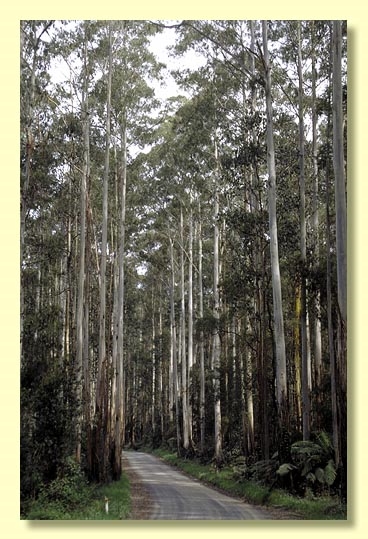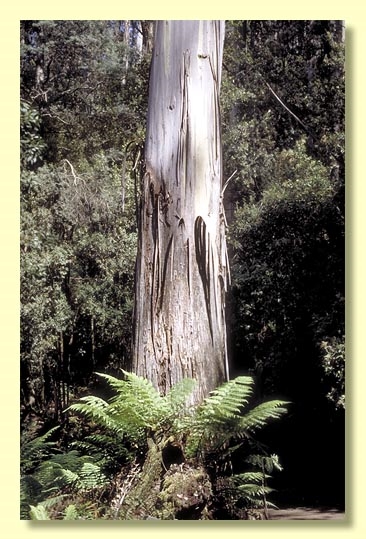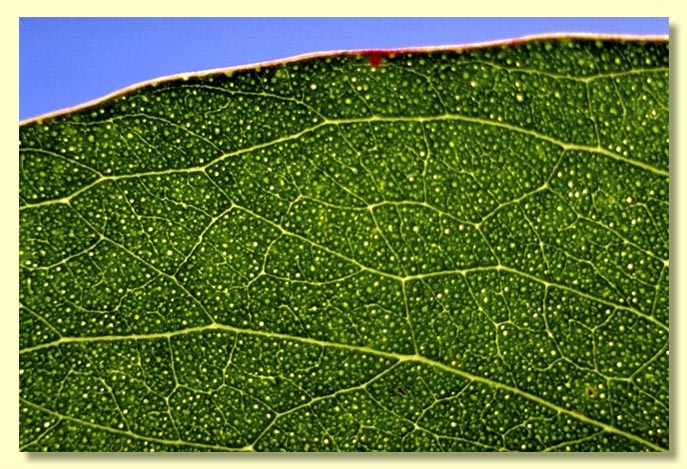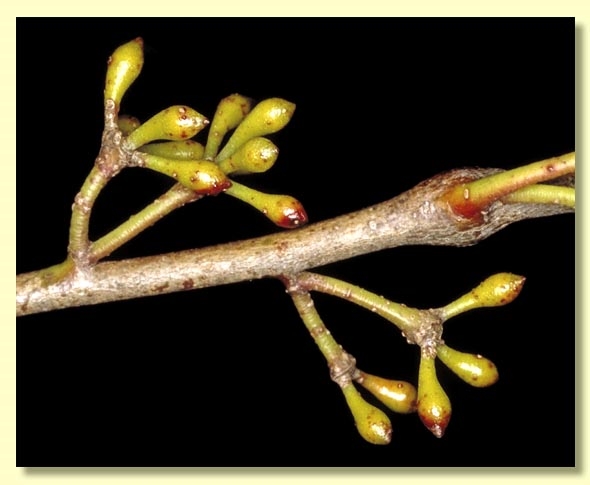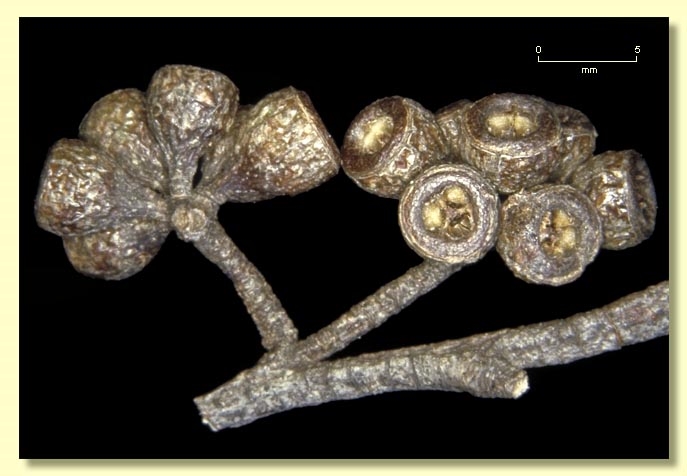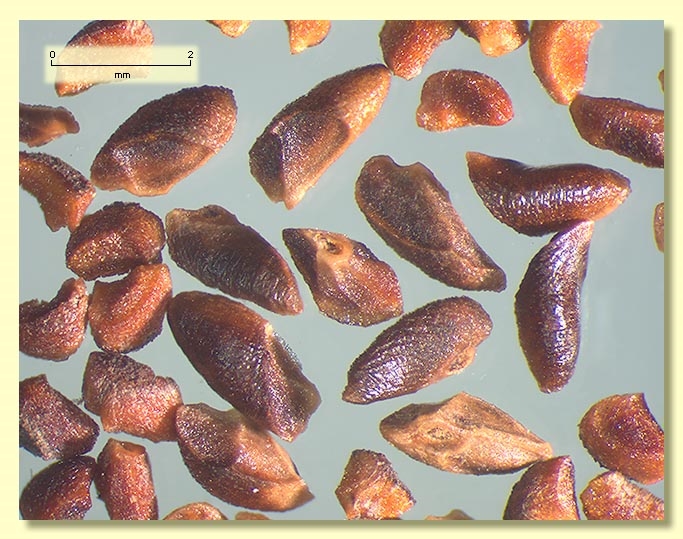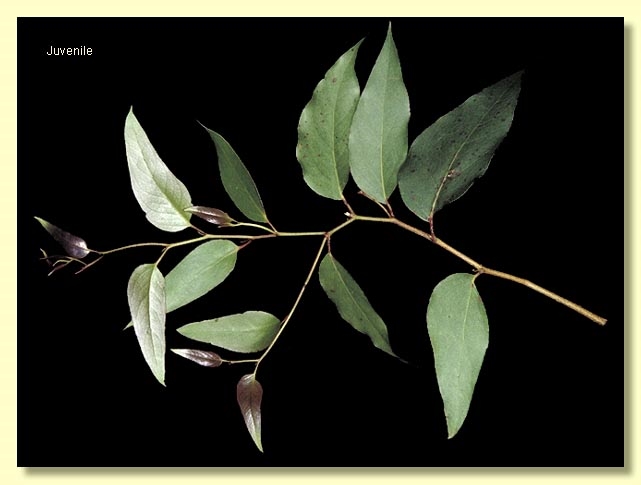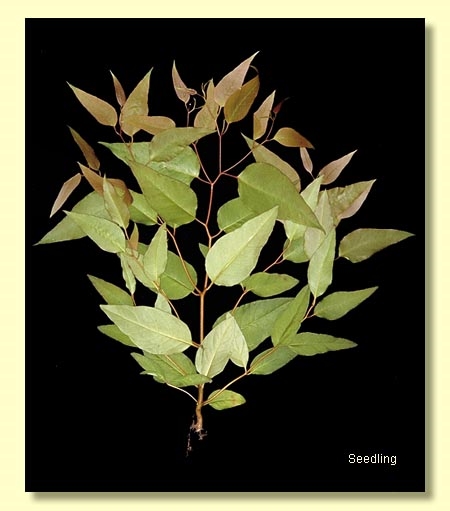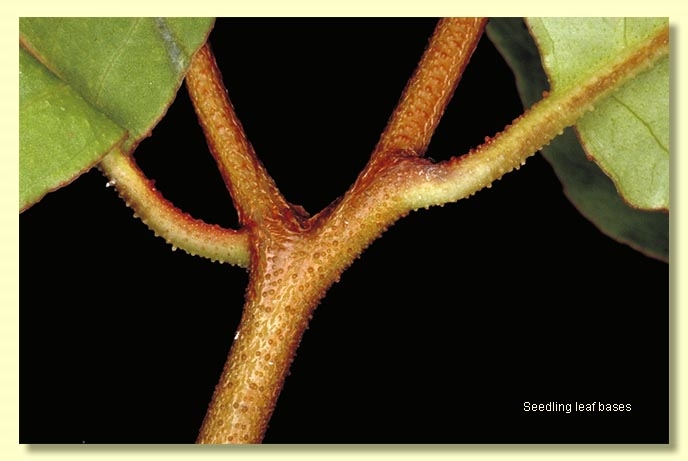Euclid - Online edition
Eucalyptus regnans
Eucalyptus | Eucalyptus | Eucalyptus | Regnantes
Bark rough for basal part of trunk, fibrous or with crumbly surface, grey, brown or black, upper trunk smooth-barked; smooth bark cream, grey-green, pale grey, brown or yellow-white, seasonally with ribbons of decorticated bark in the upper branches.
Juvenile growth (coppice or field seedlings to 50 cm): stem rounded in cross-section, smooth or warty; juvenile leaves opposite and shortly petiolate for 2 or 3 pairs then alternate, petiolate, ovate, 5.5–12 cm long, 2.2–5 cm wide, base oblique, glossy, green, held horizontally.
Adult leaves alternate, petiole 0.8–2.5 cm long; blade lanceolate to falcate, 9–23 cm long, 1.5–5 cm wide, base oblique or tapering to petiole, concolorous, glossy, green, side-veins acute, sparsely to moderately reticulate, intramarginal vein parallel to and well removed from margin, oil glands mostly island.
Inflorescence often paired umbels in axils, unbranched, or as single axillary umbels, peduncles 0.4–1.4 cm long, buds 9 to 15 per umbel, pedicels 0.3–0.7 cm long. Mature buds obovoid, 0.4–0.7 cm long, 0.2–0.4 cm wide, green, brown or yellow, scar absent, operculum rounded, often apiculate, stamens irregularly flexed, anthers reniform to cordate, versatile, dorsifixed, dehiscing by confluent slits (usually), style long, stigma blunt or tapered, locules usually 3, the placentae each with 2 vertical ovule rows. Flowers white.
Fruit on pedicels 0.1–0.7 cm long, cup-shaped or obconical, 0.5–0.8 cm long, 0.4–0.7 cm wide, disc usually slightly descending (below rim), valves usually 3, near rim level or enclosed.
Seeds brown, 1.5–3 mm long, pyramidal or obliquely pyramidal, dorsal surface smooth or minutely pitted, hilum terminal.
Cultivated seedlings (measured at ca node 10): cotyledons reniform; stems rounded in cross-section; leaves shortly petiolate, opposite, ovate and discolorous for ca 4 or 5 nodes then becoming alternate and with longer petioles, still ovate, 5–13 cm long, 2–5.5 cm wide, base rounded to tapering and later oblique, apex pointed, glossy, mid-green above, paler beneath.
Flowering has been recorded March, April and May.
A medium-sized to very tall forest tree often found in pure stands. It occurs in higher rainfall areas of the eastern highlands of Victoria south of the Great Dividing Range, east from Bonang to the Strzelecki and Dandenong Ranges, with smaller occurrences on Mt Macedon and in the Otway Ranges. In Tasmania E. regnans occurs in the north-east and the Huon and Derwent Valleys, also inland from the coast across northern Tasmania. It prefers high rainfall areas on deeper fertile soils.
E. regnans is a green-leaved ash species with only a short stocking of rough bark. It has only one close relative, E. fastigata, both having a ribbony crown and the very rare character of paired inflorescences in the axils. E. fastigata differs in having rough bark over the whole trunk and branches and fruit with a slightly domed disc. E. regnans has fruit with a slightly sunken disc. The other tall green-leaved ash species occurring in similar wet forests is E. obliqua, which differs in the rough bark to the branchlets, larger, thicker, broadly ovate, juvenile leaves, single axillary inflorescences and barrel-shaped fruit.
Eucalyptus regnans belongs in Eucalyptus subgenus Eucalyptus section Eucalyptus series Regnantes, because of the following combination of characters, tall tree habit, fibrous rough bark (on lower trunk only), alternate, green juvenile leaves, sparsely reticulate adult leaves, predominantly paired axillary inflorescences with pedicellate buds having only one operculum and reniform anthers, ovules in two rows, and more or less pyramidal seeds.

